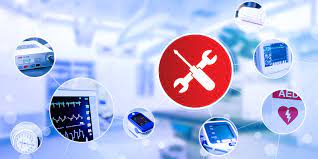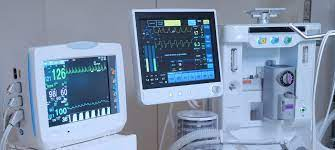In the realm of healthcare, diagnostic devices are the unsung heroes, quietly working in the background to provide accurate data for patient care. These devices, which include everything from blood analyzers to medical imaging equipment, play a pivotal role in diagnosis and treatment. To ensure their precision and reliability, regular maintenance is essential. This article delves into the importance of diagnostic device maintenance in the United Kingdom’s healthcare landscape.
Why is Diagnostic Device Maintenance Crucial?
1. Patient Safety
The primary concern in healthcare is patient safety. Faulty or inaccurate diagnostic devices can lead to incorrect diagnoses and treatment plans, potentially putting patients at risk.
2. Data Accuracy
Diagnostic devices generate critical data that informs medical decisions. Maintenance ensures that this data is accurate and reliable, which is paramount for healthcare professionals.
3. Prolonged Lifespan
Regular maintenance can extend the lifespan of diagnostic devices, ensuring that healthcare facilities get the most value from their investments.
4. Regulatory Compliance
Healthcare facilities in the UK are subject to stringent regulatory requirements. Routine maintenance is often a legal requirement to ensure compliance.
Diagnostic Device Maintenance Best Practices
1. Scheduled Inspections
Establish a regular inspection schedule for diagnostic devices. This can include daily, weekly, monthly, and annual checks, depending on the device and its criticality.
2. Calibration and Testing
Regularly calibrate and test devices to confirm their accuracy. Calibration ensures that the device provides results that are within an acceptable margin of error.
3. Preventive Maintenance
Preventive maintenance involves routine tasks like cleaning, lubricating, and replacing worn-out components. It’s a proactive management system approach to keep devices in optimal working condition.
4. Staff Training
Ensure that all personnel and staff members operating diagnostic devices are adequately trained in their operation and basic maintenance procedures.
5. Documentation
Maintain detailed records of maintenance activities, including dates, tasks performed, and the condition and function of the device. This documentation can be crucial for regulatory compliance.
6. Vendor Support
Establish a relationship with the device manufacturer or the company as an authorized service provider. Their expertise can be invaluable in maintenance and repairs.
Challenges in Diagnostic Device Maintenance
While maintenance is critical to hospital itself, healthcare facilities in the UK face several challenges in this regard:
- Resource Constraints: Healthcare budgets are often stretched thin, making it challenging to allocate resources for maintenance.
- Complex Technology: Many diagnostic devices are technologically complex, requiring specialised training and expertise for maintenance.
- Downtime: Taking a diagnostic device offline for maintenance can disrupt healthcare services, so facilities need to carefully plan when to perform maintenance.
- Regulatory Compliance: Ensuring compliance with regulations can be demanding and time-consuming.
Medical Devices
Medical devices encompass a vast array different types of equipment, instruments, and technologies used in the healthcare sector. These devices are designed to diagnose, monitor, or treat various medical conditions, ultimately improving the quality of patient care.
1. Diagnostic Devices
Diagnostic devices, such as X-ray machines, MRI scanners, and blood testing equipment, are crucial for identifying illnesses and determining appropriate treatment plans. Ensuring the accuracy and precision of these devices is essential for accurate diagnosis.
2. Therapeutic Devices
Therapeutic devices include tools like insulin pumps, pacemakers, and ventilators. They are often implanted or used externally to manage chronic conditions and save lives.
3. Monitoring Devices
Monitoring devices, like ECG machines and wearable health trackers, allow continuous tracking of patients’ vital signs and health parameters. These help in early detection of health issues.
4. Surgical Instruments
Surgical instruments are the tools used by healthcare professionals during surgeries and medical procedures. Maintaining their sterility and precision is crucial.
5. Assistive Devices
Assistive devices, including hearing aids and prosthetic limbs, enhance the quality of life for patients with disabilities.
Maintenance of Medical Devices
Maintaining medical devices is of paramount importance to ensure their effectiveness and safety. In the UK, regulatory bodies, such as the Medicines and Healthcare products Regulatory Agency (MHRA), set stringent guidelines for the maintenance of medical devices. Here are some key aspects:
Regular Inspection and Calibration
Many medical devices require regular inspections and calibration to ensure their accuracy. This is especially critical for diagnostic and monitoring devices like blood pressure monitors and imaging equipment.
Hygiene and Sterilization
Proper hygiene and sterilization protocols are essential for devices that come into direct contact with patients or bodily fluids. This knowledge is vital for surgical instruments and implantable devices.
Software Updates
In an age where software plays a significant role in healthcare devices, keeping software up to date is crucial for data security and optimal device performance.
Preventive Maintenance
Preventive maintenance strategies, like routine checks and timely part replacements, can significantly extend the lifespan of medical devices and reduce the risk of unexpected failures.
Compliance with Regulations
In the UK, medical device maintenance must adhere to strict regulatory standards. Healthcare facilities must ensure compliance with all relevant regulations to maintain patient safety and device effectiveness.
Understanding Predictive Maintenance
Predictive maintenance is a data-driven approach that utilizes technology, such as sensors, Internet of Things (IoT) devices, and machine learning, to predict when equipment is likely to fail. This predictive capability allows maintenance engineers and teams to schedule repairs or replacements before a breakdown occurs, saving time, and money, and preventing unexpected downtime.
The Significance of Predictive Maintenance
In the UK, where industries rely heavily on machinery and equipment, predictive maintenance and repair is gaining prominence for several reasons:
1. Cost Savings
By identifying issues before they cause major breakdowns, companies can avoid expensive emergency repairs and costly production stoppages. This results in significant cost savings and customer satisfaction.
2. Increased Productivity
Predictive maintenance minimizes downtime, allowing companies to maintain continuous production and meet delivery schedules consistently.
3. Improved Safety
Identifying potential equipment failures in advance enhances workplace safety by preventing accidents and hazardous situations.
Extended Equipment Lifespan
Regular maintenance based on predictive insights can prolong the lifespan of expensive machinery and equipment.
Energy Efficiency
Predictive maintenance can help optimize equipment performance, reducing energy consumption and environmental impact.
The Implementation of Predictive Maintenance
The successful implementation of predictive maintenance systems involves several key steps:
1. Data Collection
Collecting data from sensors and other monitoring devices is the first step. This data includes information about surface temperature, equipment performance, temperature, vibration, and more.
2. Data Analysis
Machine learning algorithms, artificial intelligence and data analytics are used to process the collected data. Patterns and anomalies are identified to predict potential issues.
3. Condition Monitoring
Equipment conditions are continuously monitored in real-time. Any deviation from the normal operating state or conditions triggers alerts.
4. Scheduling Maintenance
Predictive maintenance generates actionable insights that help in scheduling maintenance activities during planned downtime.
5. Performance Evaluation
Post-maintenance, the performance of the equipment is assessed to ensure the effectiveness of the scheduled maintenance activity.
The Role of Technology in Predictive Maintenance
In the UK, advanced technology is at the heart of development of predictive maintenance:
1. Internet of Things (IoT)
IoT devices are embedded in equipment, allowing real-time data collection and remote system monitoring.
2. Sensors and Instrumentation
Sophisticated sensors measure various equipment parameters, providing a wealth of raw data for analysis.
3. Big Data and Analytics
Data analytics tools sift through vast amounts of information to identify patterns and predict potential failures.
Machine Learning
Machine learning models continuously improve their predictive accuracy as they process more and data sets.
Medical Equipment
Medical equipment comprises a broad range of tools, devices, and instruments used in healthcare settings. These instruments are designed to aid healthcare professionals in diagnosis, treatment, monitoring, and patient care. Here are some key categories of medical equipment:
1. Diagnostic Equipment
Diagnostic equipment, and systems such as X-ray machines, MRI scanners, ultrasound devices, and blood testing equipment, plays a critical role in identifying diseases and medical conditions. These devices are essential for accurate diagnosis and treatment planning in many cases.
2. Treatment Equipment
Treatment equipment includes devices like surgical instruments rotating machines, infusion pumps, and dialysis machines. They are used in hospitals to administer treatments and medical procedures to patients.
3. Monitoring Devices
Monitoring devices, such as ECG machines, pulse oximeters, and blood pressure monitors, were developed to help healthcare professionals track vital signs and health parameters continuously. This aids in early detection of health issues and effective patient care.
4. Assistive Devices
Assistive devices, including hearing aids, mobility aids, and prosthetic limbs, are designed to enhance the quality of life for patients with disabilities.
Operational Efficiency
Operational efficiency is all about doing more with less. It’s about streamlining processes, reducing waste, and optimising resource utilisation. Organizations that achieve high operational efficiency can produce goods or deliver services faster, at a lower cost, and with fewer errors.
What is Real-Time Monitoring?
Real-time monitoring involves the continuous and instantaneous collection, processing, and analysis of data. It allows organisations to track, analyse, and respond to events as they happen. In essence, real-time monitoring provides a live view of activities, enabling informed and timely decision-making.
In the UK’s healthcare landscape, diagnostic device maintenance is a non-negotiable aspect of patient care. It’s because corrective maintenance is about more than just fixing what’s broken; it’s about proactively ensuring that these devices operate at their best, providing accurate data for healthcare professionals to make informed decisions. By investing in maintenance, healthcare facilities uphold the highest standards of patient safety and data accuracy, ensuring that their diagnostic devices continue to be the unsung heroes of healthcare.
Frequently Asked Questions (FAQs)
- Why is regular maintenance of diagnostic devices essential? Regular maintenance ensures the accuracy and safety of diagnostic devices, allowing healthcare professionals to make informed decisions and provide better patient care.
- Can I perform maintenance on diagnostic devices myself? Some basic maintenance tasks can be done in-house, but it’s advisable to have professionals handle more complex maintenance to ensure accuracy and safety.
- What are the consequences of neglecting diagnostic device maintenance? Neglecting maintenance can result in inaccurate readings, device malfunctions, and potential safety hazards for patients.
- How can healthcare facilities save money on diagnostic device maintenance? Cost-effective maintenance practices and preventive maintenance can help healthcare facilities save on maintenance costs in the long run.
- What is the role of training in diagnostic device maintenance? Proper training for healthcare professionals is essential to ensure that maintenance is performed correctly, extending the lifespan and accuracy of diagnostic devices.

